Painting an Intuitive Fantasy
This week, I have a new fantasy painting, and I also share tips about selecting colors.
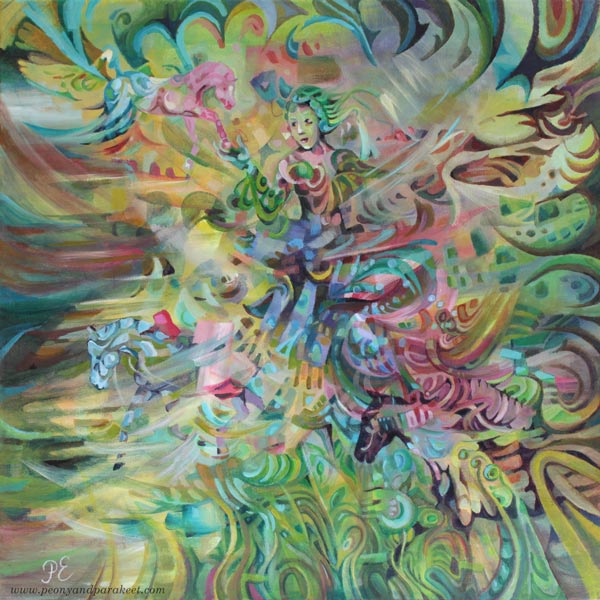
This painting is called “Arotuuli,” which is “Steppe Wind” in English. “Aro” must be one of the few words that are shorter in Finnish than in English, as Finnish words are often very long. We write compound words without space, so it makes words look even longer.
Intuitive Fantasy Painting – Two Tips for the Beginning
I like to paint intuitively, and even if this painting has horses and a woman, it started with random strokes and abstract blocks, and I had no other idea than a secret wish to be able to include a horse at some point.
Tip 1 – Dark and Light
When filling the canvas with color, I like to make dark and light color mixes so that the 3-dimensional effect tickles my imagination.
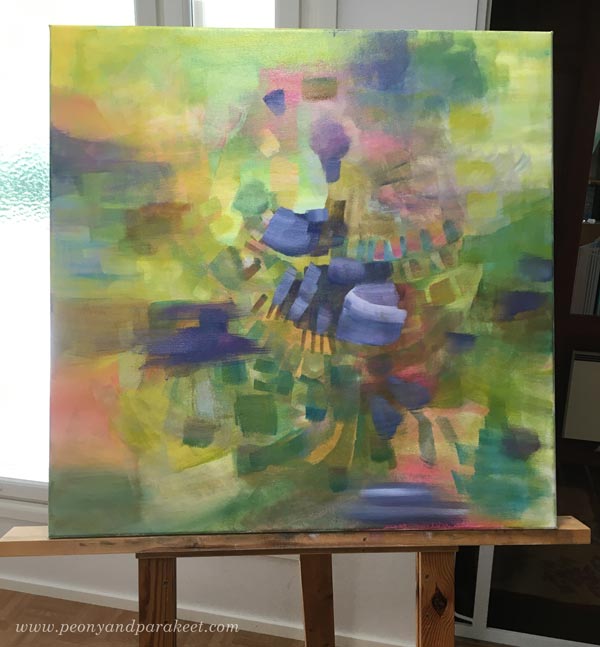
Tip 2 – Less Can Be More
I also like to pick a narrow selection of colors so that the elements look like they are exposed to the same light. In this painting, I mostly used Phthalo Turquoise, Alizarin Crimson, Yellowish Green, and Titanium White. When mixing colors, less can be more!
A Couple of My Favorite Colors
I am especially fond of Yellowish Green and Alizarin Crimson, and I recommend them warmly. Let’s talk about them a bit more.
Color 1 – Yellowish Green
Yellowish Green is a color mix manufactured by Schminke Primacryl. I bought this tube because I love Daniel Smith’s Rich Green Gold in watercolors, and I wanted to have a similar tone in acrylics. I like colors that remind me of lemons and lime fruits – one of the most beautiful things in the world – and I always find use for yellows. This color is like two colors in one tube: it works very well with the mixes that require yellow, but it also produces beautiful greens with blues.
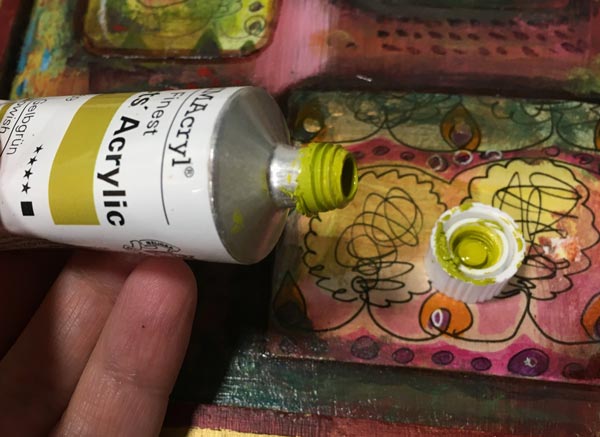
Color 2 – Alizarin Crimson
Alizarin Crimson is an ugly red. I don’t think you would buy it if you didn’t know more about it. It looks like dried blood but works very well with color mixes. White reveals its gentler side, and when mixed with blues, you can get beautiful blacks, browns, and dark purples. It produces a pleasant and quite sunny orange with yellows, and in general, it’s a workhorse, always willing to step in.
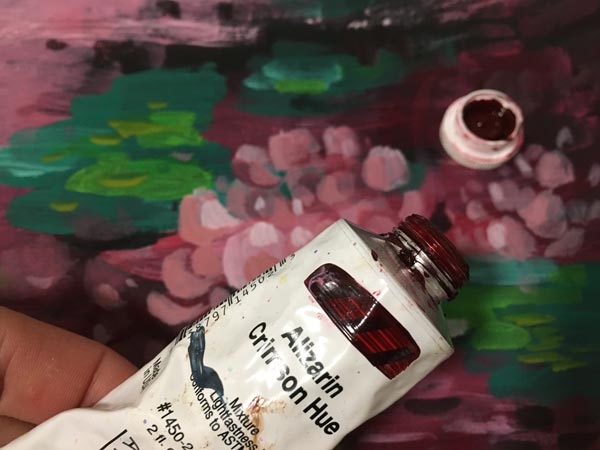
Alizarin Crimson was originally manufactured from madder, but these old organic dyes faded or changed within time, so nowadays we use synthetic substitutes. I found this color in oils first. Schminke’s oil paint is called “Alizarin Madder Lake”. My tube, manufactured by Golden, is “Alizarin Crimson Hue”. Alizarin Crimson is sometimes called “Madder Lake” or “Alizarin Red,” and the tone may vary. Pick the darkest and ugliest one!
If you are a color nerd, Bright Earth by Philip Ball is a comprehensive book about pigments and their origin.
Here’s the painting before I started adding the figures. The image shows well how Yellowish Green and Alizarin Crimson work in color mixes.
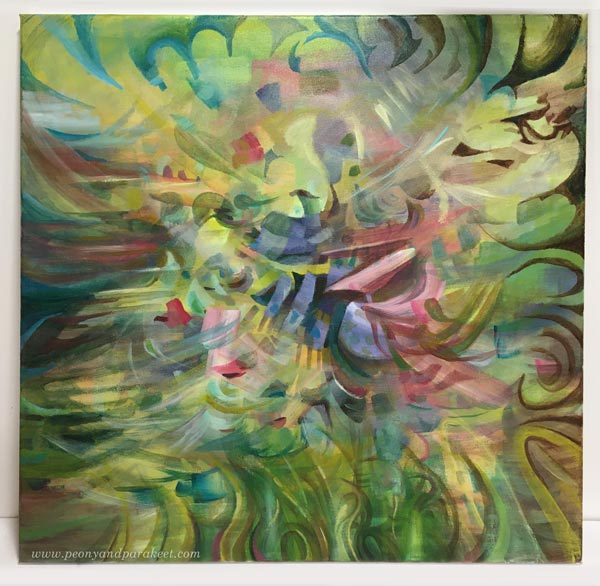
Intuitive Fantasy Shape by Shape
I painted the woman and the horses so that they are partly abstract and partly realistic. Some shapes exist just because they look beautiful, others because they are building blocks for the figures.
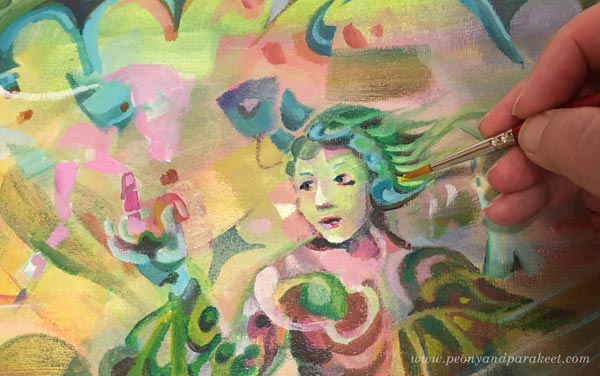
Here are some details of the finished painting. The more you zoom in, the more abstract the painting looks.
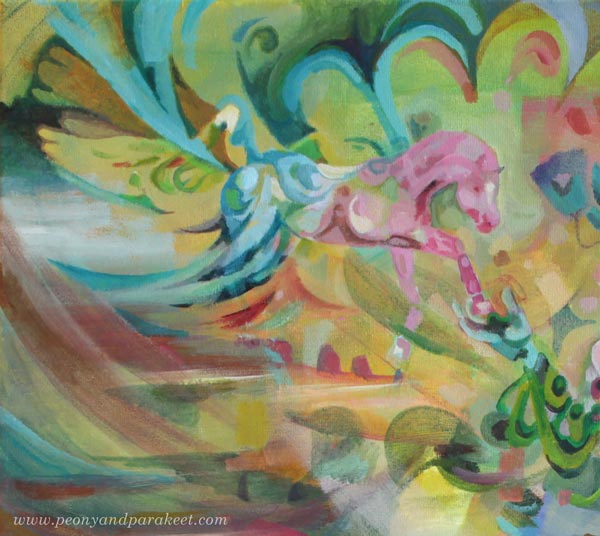
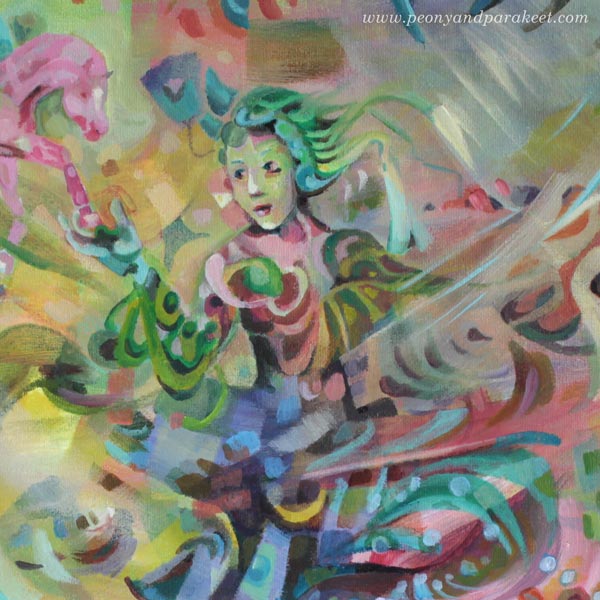
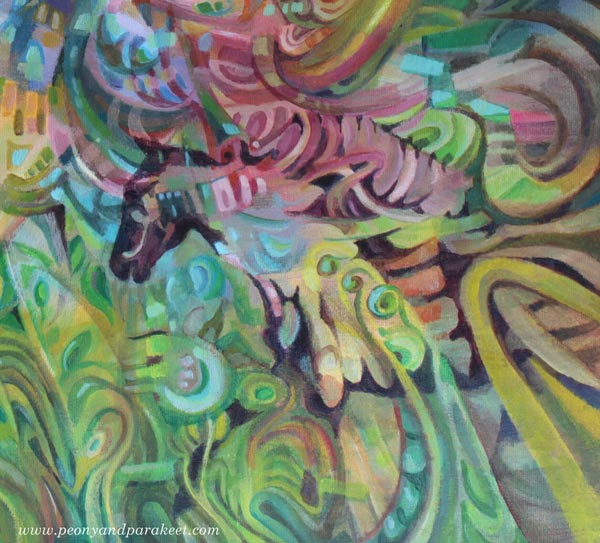
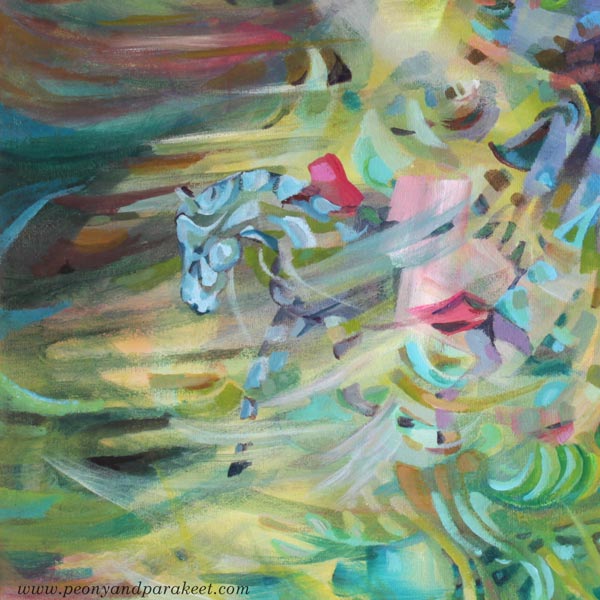
Here’s the whole painting again.

I wanted to keep the colors light and bright to create an airy impression.
Intuitive Fantasy Painting – Big or Small?
“Arotuuli” is one of my biggest paintings. It’s 60 x 60 cm (about 23,5 x 23,5 inches) and painted on a stretched, fairly thick canvas. I like painting on smooth surfaces. My style is detailed, and the coarse structure doesn’t go well with it. The painting was started about a month ago, and I took few-hour sessions now and then. It’s not as slow as you would think, because the small strokes aren’t as tiny as with small pieces. Sometimes we produce clumsy just because we select a small size. For me, the bigger size has helped to create dynamic scenes rather than static portraits. “Arotuuli” continues the previous bigger painting “Paratiisi / Paradise.”
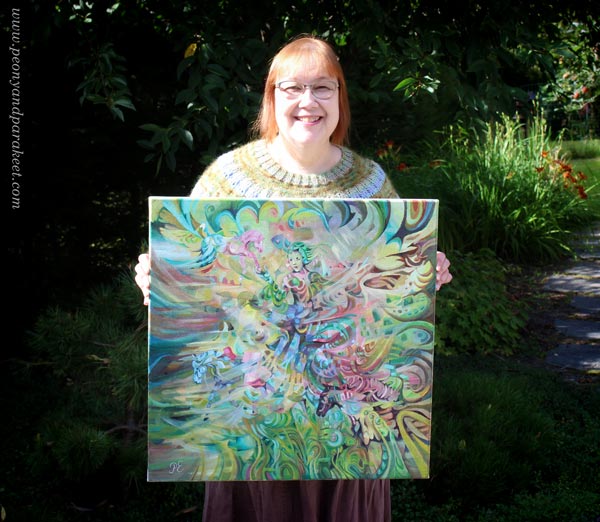
But next week, something much smaller, even if I do have a new big canvas waiting!
Art Journal Video – Adding Text and Layers to Your Pages
This week is all about art journal inspiration. You see more spreads from the art journal I started a couple of weeks ago, and there’s also a video of making the spread below.
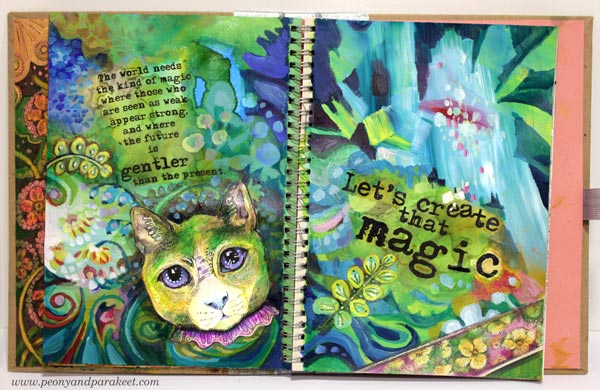
The world needs the kind of magic
where those who are seen as weak appear strong,
and where the future is gentler than the present.
Let’s create that magic!
Including Text in Art Journal Pages
I have a pile of these kinds of small stories about art and imagination. Or maybe I should say “a feed” instead of “a pile” because I post them regularly on Peony and Parakeet’s Facebook page. I have always liked writing, and I have a natural urge to share thoughts about my passion. So it hit me that I should write more in my art journals too. And why not use those stories that are born so effortlessly every week?
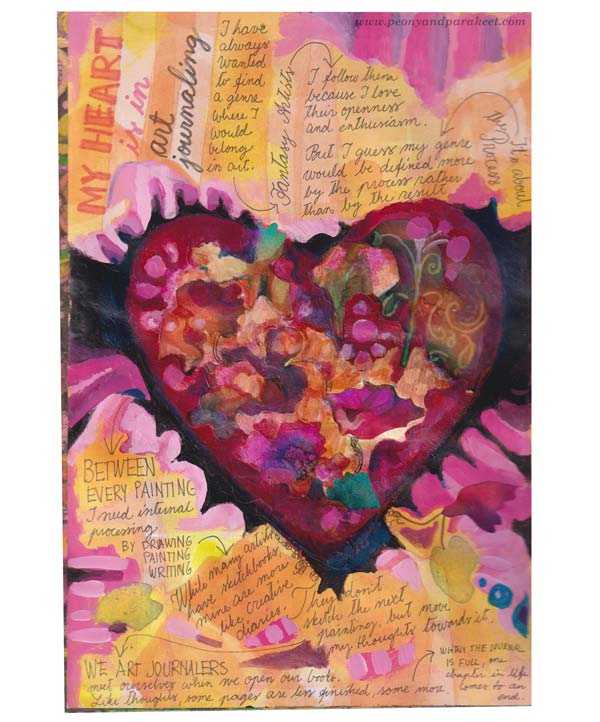
I have always wanted to find a genre where I would belong in art.
I follow fantasy artists closely because I love their openness and enthusiasm.
But I guess my genre would be defined more by the process rather than by the result.
Between every painting, I need internal processing by drawing, painting, and writing.
While many artists have sketchbooks, mine are more like creative diaries.
They don’t sketch the next painting but move my thoughts towards it.
We art journalers meet ourselves when we open our books.
Like thoughts, some pages are less finished, some more,
and when the journal is full, one chapter in life comes to an end.
Art Journal Pages with Typed Text Blocks
After writing by hand, I decided to make the next page so that the text would be typed. Not that I hate my handwriting, vice versa, hand-written pages always look great. But when I was a child, I used to write a lot with an old Bijou, and I missed the typed look. I still have the old typewriter, but the possibility to play with the size and style of the letters, made me use a computer instead.
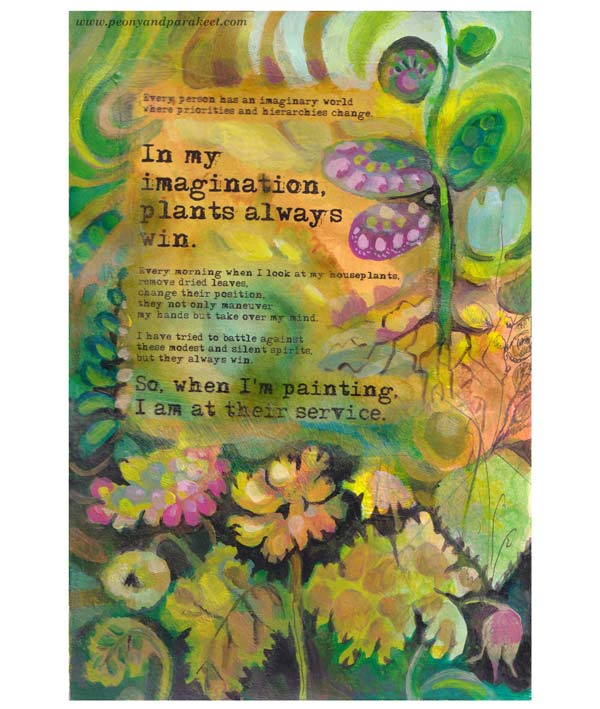
Every person has an imaginary world where priorities and hierarchies change.
In my imagination, plants always win.
Every morning when I look at my houseplants,
remove dried leaves, change their position,
they not only maneuver my hands but take over my mind.
I have tried to battle against these modest and silent spirits, but they always win.
So, when I’m painting, I am at their service!
Here’s the spread with the two pages side by side.
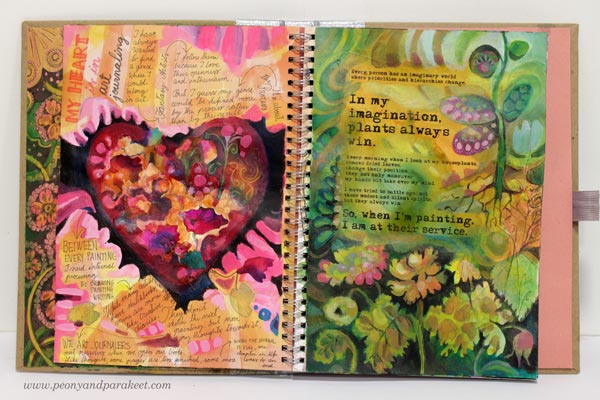
In the second spread, I wanted to play with the orientation and the shape of the text blocks.
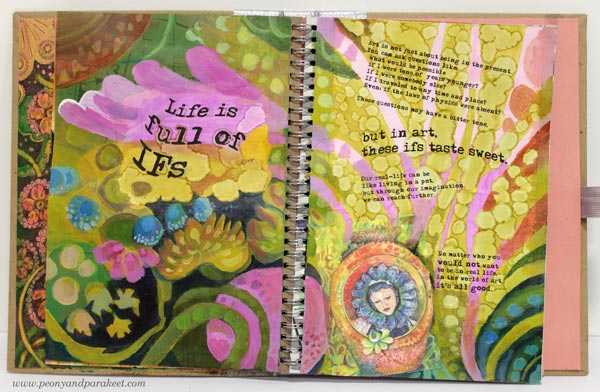
Art is not just about being in the present. You can ask questions like:
What would be possible if I were tens of years younger?
If I were somebody else?
If I traveled to any time and place?
Even: if the laws of physics were absent?
These questions may first have a bit bitter tone,
but in art, these ifs taste sweet.
Our real-life can be like living in a pot,
but through our imagination,
we can reach further.
No matter who you would not want to be in real life,
in the world of art, it’s all good.
Mixed Media Art Journal Pages
For the second spread, I printed a gouache painting that I had made for the class Decodashery on a sticky canvas and adhered it on the page.
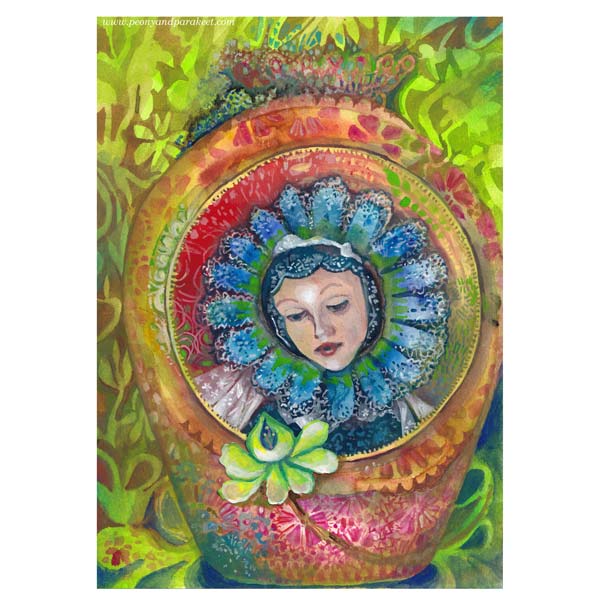
I really like the yellow-green circles, made with alcohol inks.
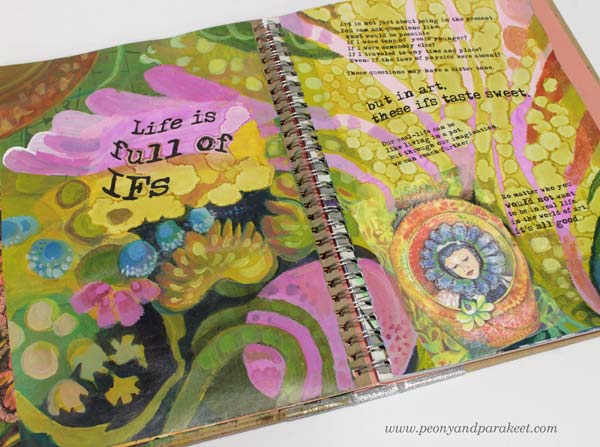
In this spread, I also used hand-drawn and hand-painted collage pieces made from the classes Magical Inkdom and Decodashery.
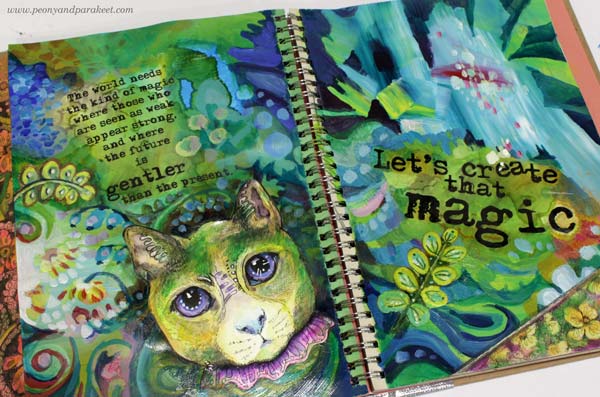
I added green to the cat so that it fits with the rest of the page.
Art Journal Magic – Watch the Video!
See the process of attaching printed text, using alcohol inks, and painting with acrylics more in detail by watching the video below!
I hope the video inspired you to fill your journals!
Draw animals and more: Animal Inkdom, Magical Inkdom
Paint decorative flowers and more: Decodashery
New Oil Painting and Pretty Art Journaling
This week, I have finished an oil painting and started an art journal that I want to make as pretty as possible. I also talk about my aspire to paint horses and ask how deep you have to know the subject to own it in your art. This post has lots of pics!
Wreath Maker – Painting with Oils Like They Would be Watercolors
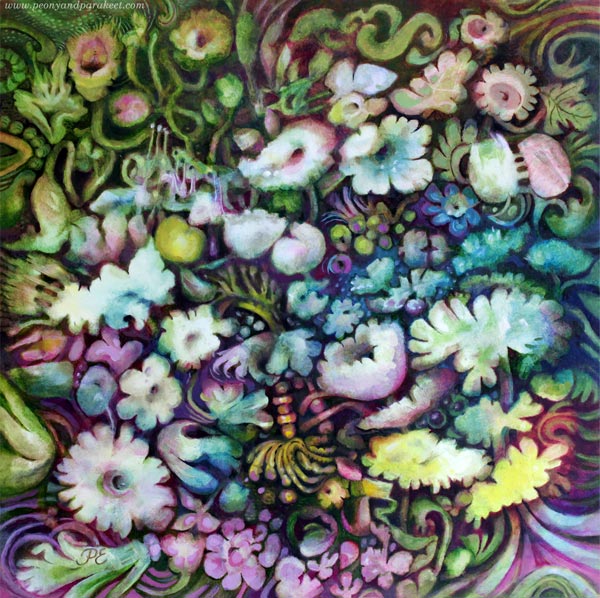
I started this painting in January, and I am so glad that it’s finally finished. Even if this is an oil painting, I used the approach that’s best for watercolors – I started with pale pastels and worked towards darker tones. I really like painting like this, and the result pleases my eye. The pictures below show the process and I have also blogged about this painting in May 2020.
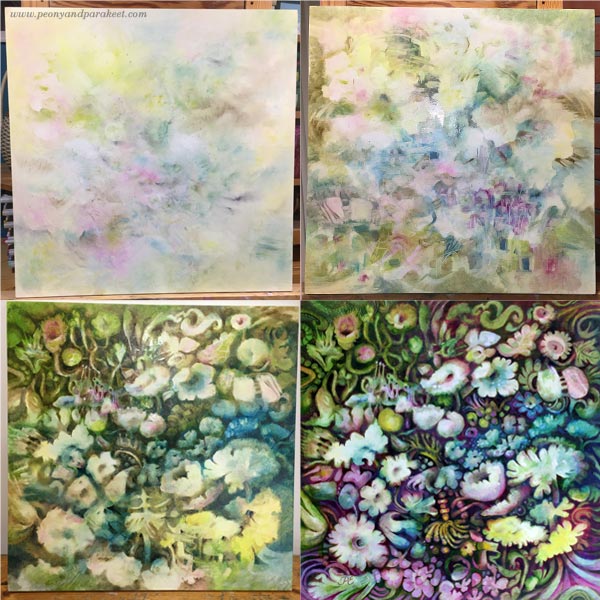
The Series of Three Floral Paintings
The painting is called “Seppeleentekijä – Wreath Maker”. It’s the last one for the series of three paintings. The two first ones are watercolor pieces called “Jäänmurtaja – Ice Breaker” and “Soihdunkantaja – Torch Bearer.” I made the paintings so that they could be seen as a triptych where the flowers of the two watercolor paintings lean towards the centerpiece. Click the image below to see the series as a bigger picture!

The Shelf of Art Journals – Re-Organizing the Studio
Making the three paintings was quite an accomplishment, and finishing the last piece made me feel empty. What to do next? Well, I don’t know about you, but if I need recreation, cleaning and organizing is the thing! While going through the stuff on the shelves of my little studio, I gathered the sketchbooks and art journals in one place.
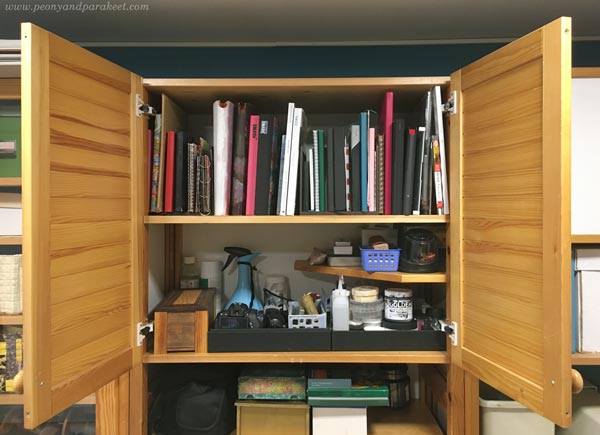
Smash Books – Do You Still Remember Them?
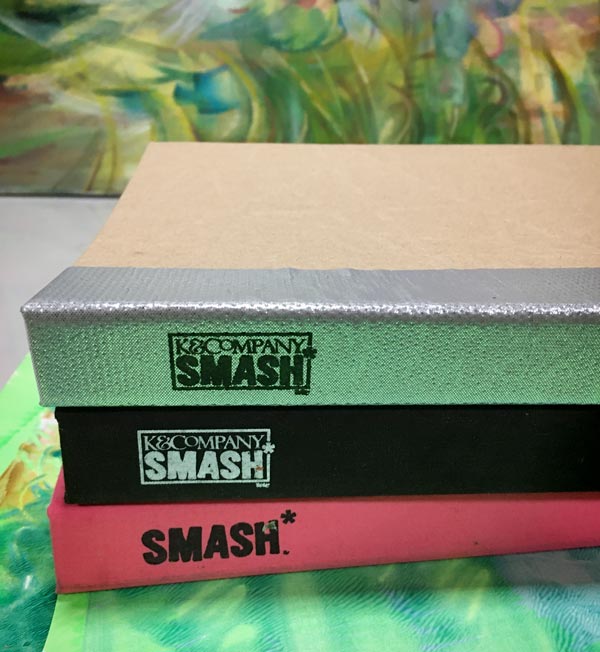
I found one almost empty old Smash Book – do you remember the time when everybody had them? See the flip-through videos of my two Smash Books here:
>> Pink Smash Book Flip-Through
>> Black Smash Book Flip-Through
The third Smash Book has a silver back and with that, I remembered how back then, all the art journals were more or less messy. In 2012, I daringly wrote a blog post that asked: “Can’t there be pretty art journaling?”
So it hit me, that the extra Smash Book could continue the tradition of the two past ones and be a pretty art journal. It could also be my tool for encouraging myself to paint what I really want, and not fall into the trap of trying to paint what seems more appropriate. Namely, I would like to paint things like … (gasping a bit)… ahem … HORSES! I tried to make a long list, but all I could think of was HORSES.
Horses – Can only an Expert Paint Them?
You see, I am no expert in horses, I have ridden on a horse only once, as a child, and I have never been living close to a stable. But I had toy horses, and I have always admired their beauty. I have tried to get rid of this disease by drawing zebras for the class Animal Inkdom, and horses for its independent sequel Magical Inkdom, but it hasn’t gone away.
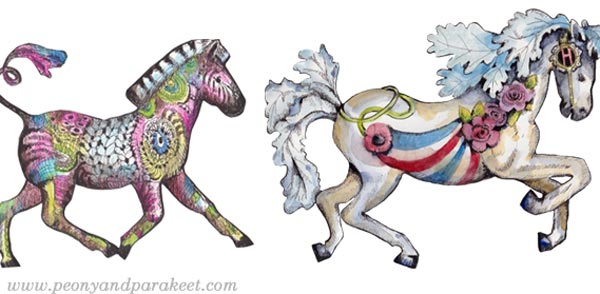
Can you paint something you are no expert in? Many years ago, I heard an interview with an artist who said that everything clicked when he started painting cows. He had been living with them most of his life, and he knew exactly how they are. You have to know what you paint, he claimed, as far as I can remember. It makes sense. I love plants and have always been growing some. I feel I know the soul of flowers and in the oil painting that I just finished, I wanted the flowers to reveal their soul, to be chatty and curious, just like they are if you silently observe them very, very closely.
But isn’t it possible to use the expertise for other things too – to transfer the soul of a flower to a horse, and thus, regain the mastery? To use the flowery language from Decodashery to express a moving thing?
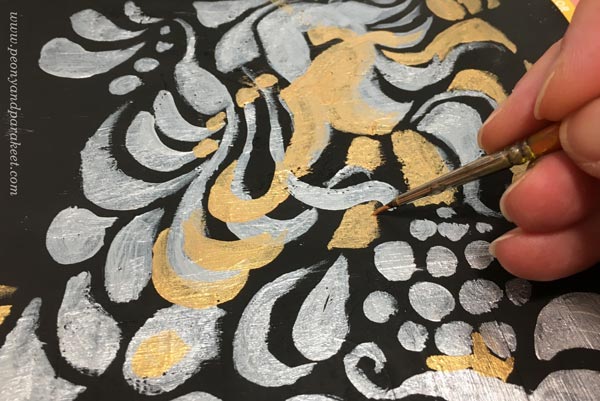
It doesn’t have to be anything grand at first, just a small art journal page.
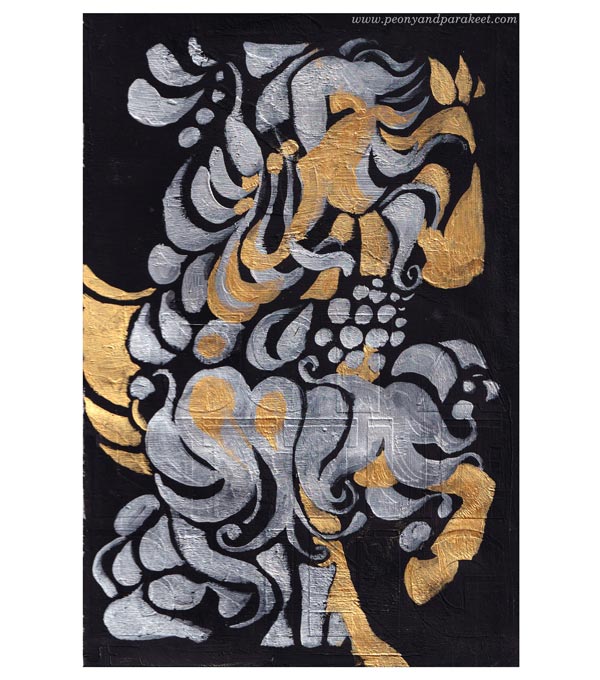
Pretty Art Journaling Can Be Reverse Creative Exploring
If I can paint a horse in the language of flowers, couldn’t it also be possible to revert the process? Could I make an art journal page from the painting, a sketch after a result?

I want to allow this free flow from one theme and one media to another happen again with this journal.
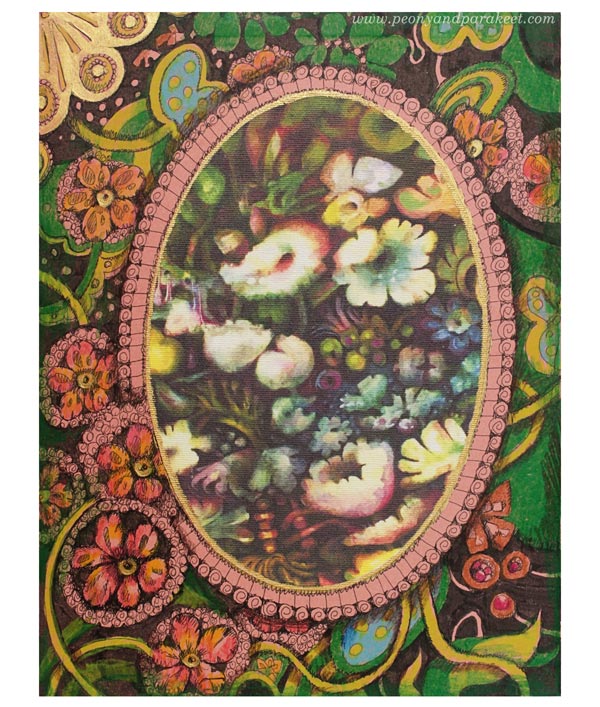
The image of the painting was printed on a sticky canvas bought ages ago. Then I drew and colored the floral frame, and added some gold and silver paint too. Here’s the first spread of the “new” Smash Book – the new beginning of pretty art journaling!
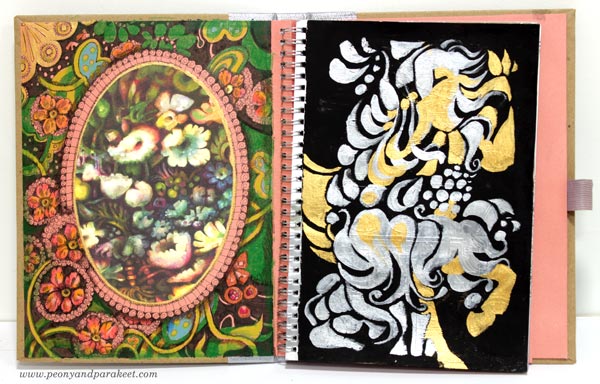
Handmade Picture Shelf Finishes the Display
A part of reorganizing was to get a picture shelf on the wall. My skillful husband made it, and I absolutely love it.
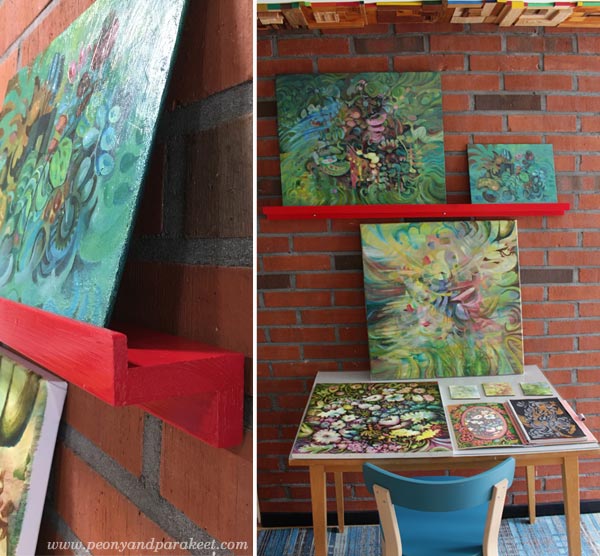
Finished paintings, paintings in progress, and art journal spreads can now be displayed together.
Tell me, what inspires you at the moment?
What do you put in your list of what to paint or draw?
Classes which inspired this post:
Animal Inkdom – Draw and decorate wild animals! – Buy here!
Magical Inkdom – Draw the magic of mysteries and fairytales! – Buy here!
Decodashery – Paint beautiful florals and more! – Buy here!
Flowers masterclass: Floral Fantasies – Buy here!
Intuitive Painting Step by Step
This week, we are creating an intuitive painting step by step. This project is more about following a process and mindset than trying to replicate my example.
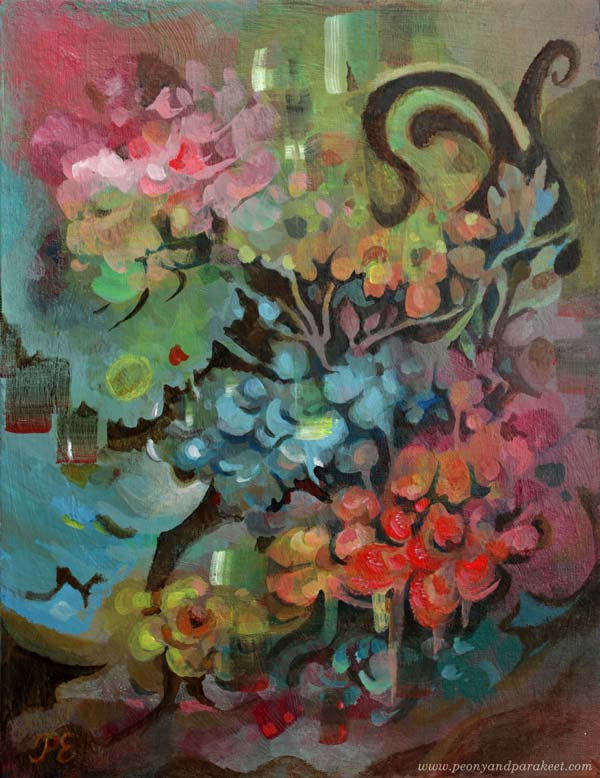
I call this “Deer to Dream” because if you look at it from a distance, it looks like a bunch of flowers the view is more interesting when you find the deer. This is a small acrylic painting, 35 x 27 cm (about 13,5 x 10,5 inches).
Step 1 – Explore Mud – Paint a Background
Pick a few tubes and mix colors freely. Allow mud to be born!
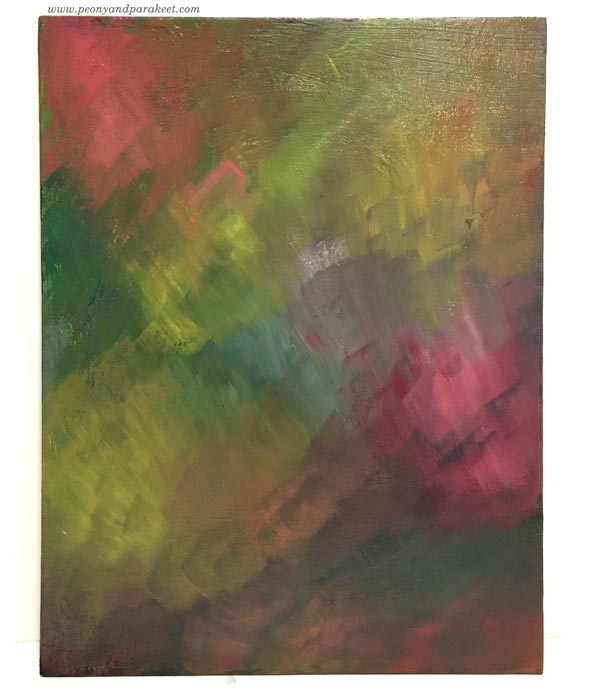
Don’t expect clarity right from the beginning, but trust that the painting process will purify your mind. The muddy start will make you grounded.
Step 2 – Take a Flight – Paint a Flock
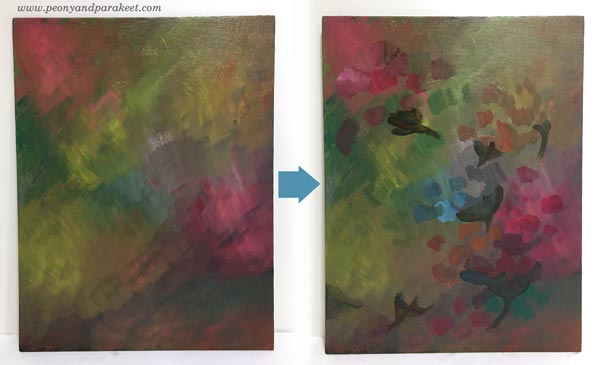
With a bit brighter tones, add strokes so that they make a stream across the painting. Paint dark shapes so that they group the strokes.
Keep the focus on expressing the movement rather than trying to create something accurate and realistic. The groups can be flowers or birds or anything that comes to your mind.
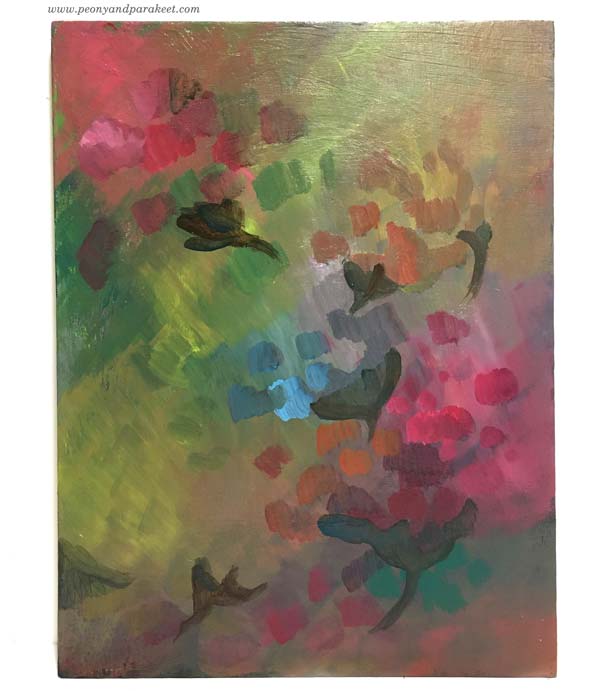
Your spirit has raised from the mud and begun a journey to a new world.
Step 3 – Land Towards the Light – Add Bright Pastels to the Flock
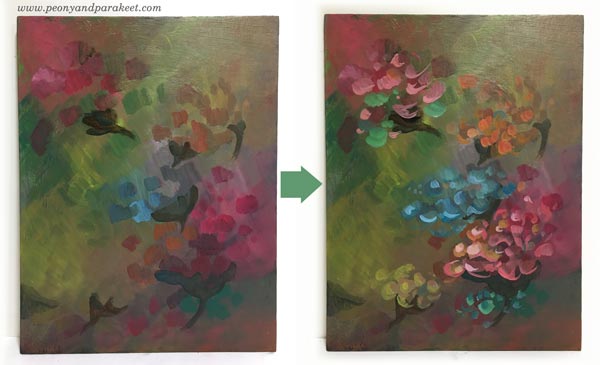
Mix white to the colors, and add bright strokes to the elements. They are now exposed to light, and the flight is getting closer to its destination.
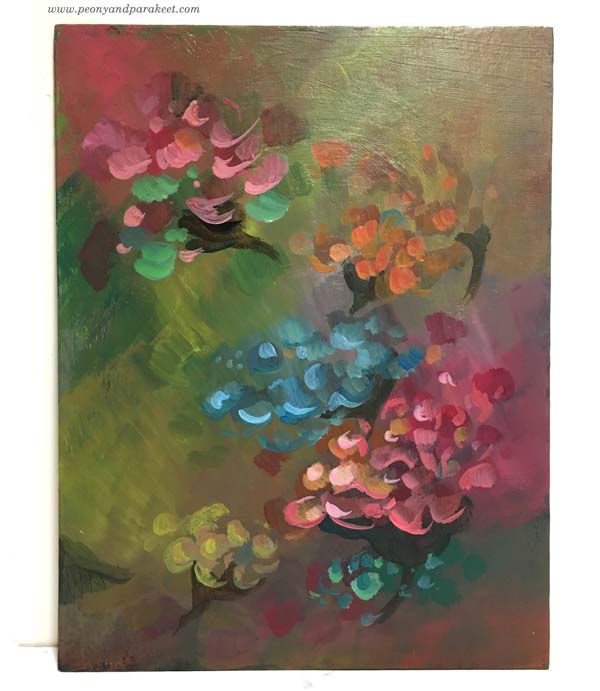
You can leave the painting like this, but for me, intuitive painting is an adventure rather than a safe performance, something that includes risk and excitement, and we haven’t gone far enough yet. So, let’s keep painting!
Step 4 – Become Adventurous – Paint over the Elements
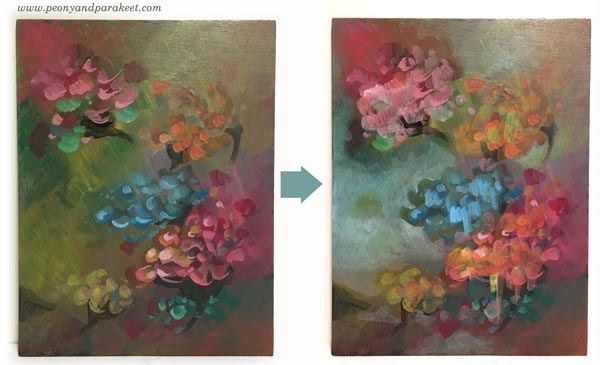
When we want to deepen the process, disruption is needed. Use a little bit more water and make brush strokes that partly cover what you have painted so far.
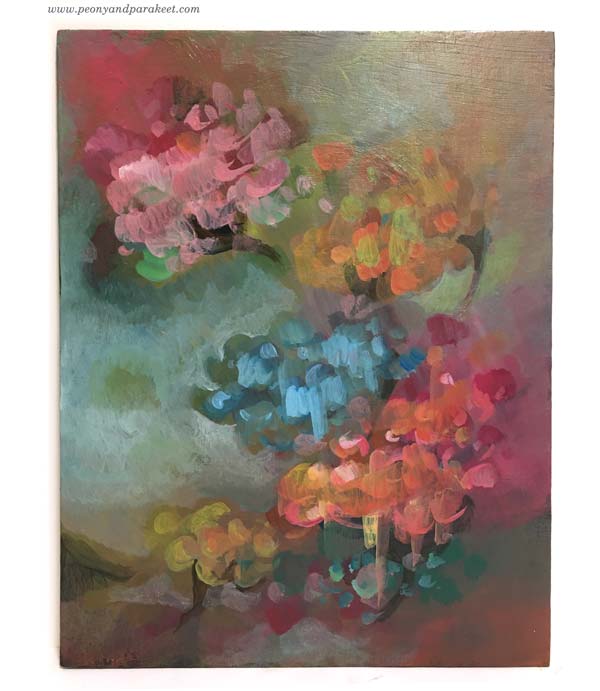
New layer is like an emotion that takes over. It makes the painting messier, but also freer and more open to new ideas.
Step 5 – Explore the Wilderness – Paint Details
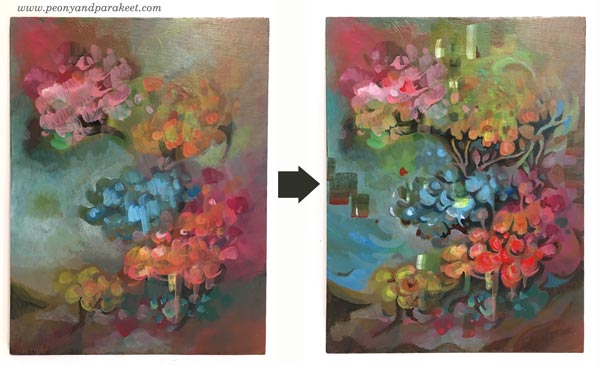
The painting is now like a wilderness, and you need to know its every corner. Slowly go through every small area and forget the big picture. Make paths from one element to another, allow some parts to become more intense than others, and add little spots and strokes where you want the eye to stop and admire the view.
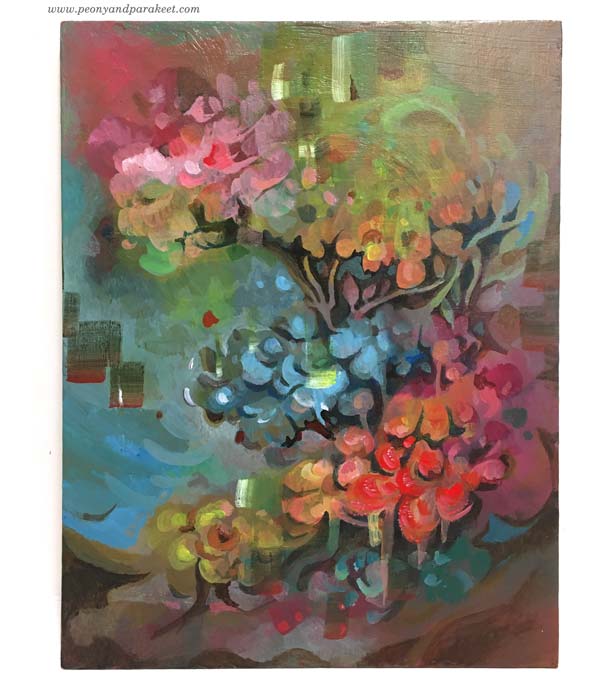
Imagine that every shape has a personality and that it’s your mission to make the shapes interact with each other. Connections can be built so that they share a line, a color, or form.
In this step, you begin to experience creative freedom. At first, it’s like a smell that you become slowly aware of. It’s a possibility to take a new direction and follow your instinct. So again, let’s keep painting!
Step 6 – Dare to Dream – Meet a Spirit
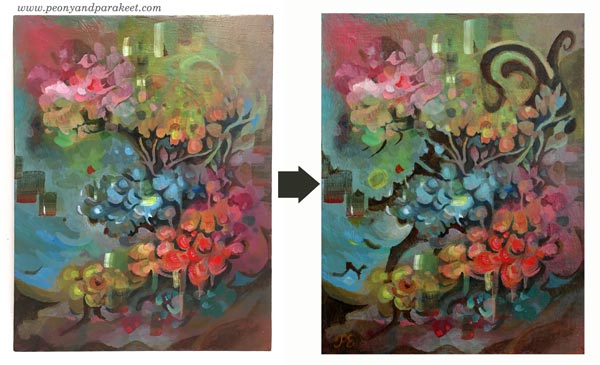
Dare to dream further than what you would expect in the beginning! Every painting has a spirit and your mission as an intuitive painter is to recognize it. Even if it’s you who created the painting, the spirit is free.
Feeling the presence of the painting’s spirit is often enough, but recently, I have dared to look at it to the eye and paint it too.
You may also want to read my previous post about artistic spirit!
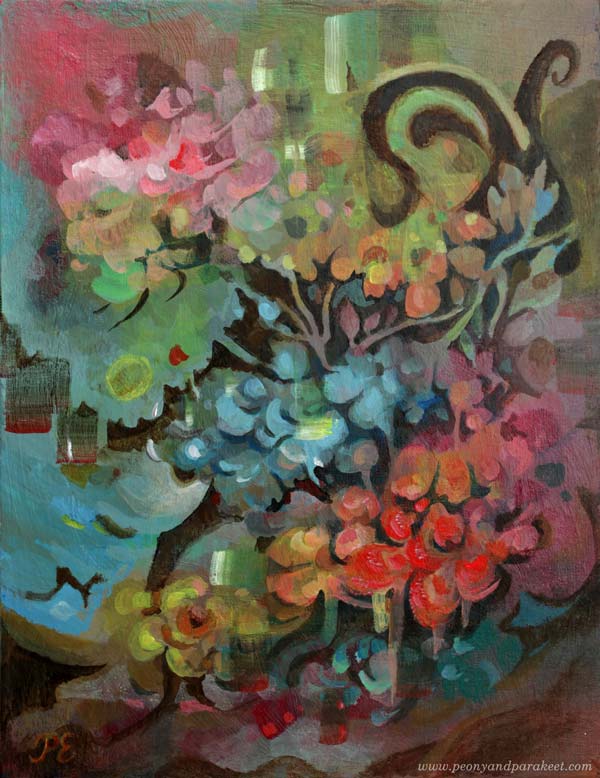
Intuitive Painting Step by Step with Watercolors?
I used acrylic paints for the project but it’s possible to follow the process for watercolors too. Here are my additional tips for watercolors:
- Start with lots of water and very light tones.
- Let the painting dry between every step.
- Slowly darken the color palette of the painting towards the last step.
More to Come – A Big Intuitive Painting in Progress
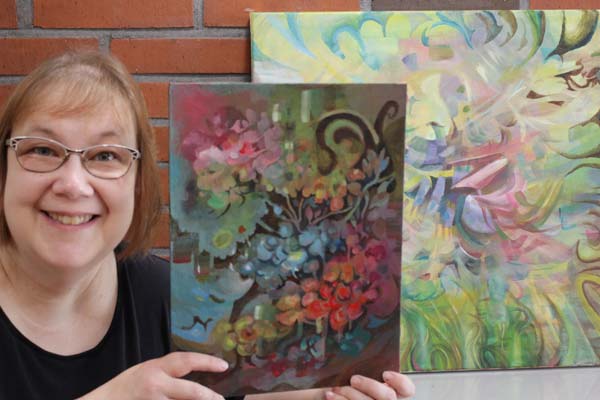
I hope that you enjoyed this project! I also have a big intuitive painting in progress, and I am excited about how it has taken off. I will talk more about it in upcoming posts.